Belkin F5D7230E Wireless G Router User Manual P74559 G F5D7230 4 manual indd
Belkin International, Inc. Wireless G Router P74559 G F5D7230 4 manual indd
Belkin >
Contents
- 1. Users Manual 1
- 2. Users Manual 2
- 3. Users Manual 3
Users Manual 2
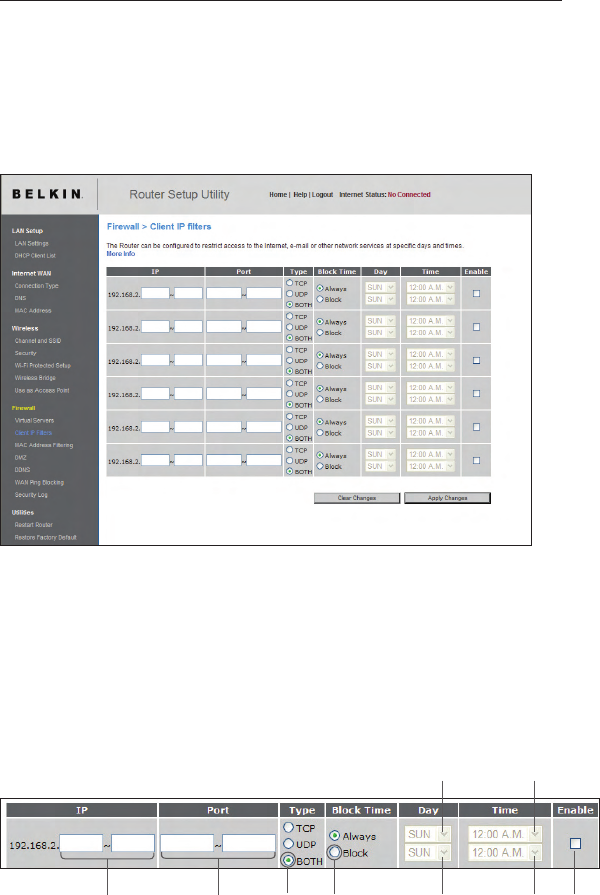
72
Using the Web-Based Advanced User Interface
72
Setting Client IP Filters
The Router can be configured to restrict access to the Internet, email, or
other network services at specific days and times. Restriction can be set for
a single computer, a range of computers, or multiple computers.
To restrict Internet access to a single computer, for example, enter the IP
address of the computer you wish to restrict access to in the IP fields (1).
Next, enter “80” in both the port fields (2). Select “Both” (3). Select “Block”
(4). You can also select “Always” to block access all of the time. Select the
day to start on top (5), the time to start on top (6), the day to end on the
bottom (7), and the time to stop (8) on the bottom. Select “Enable” (9). Click
“Apply Changes”. The computer at the IP address you specified will now be
blocked from Internet access at the times you specified. Note: Be sure you
have selected the correct time zone under “Utilities> System Settings>
Time Zone”.
(1) (2) (3) (4) (7) (8) (9)
(5) (6)
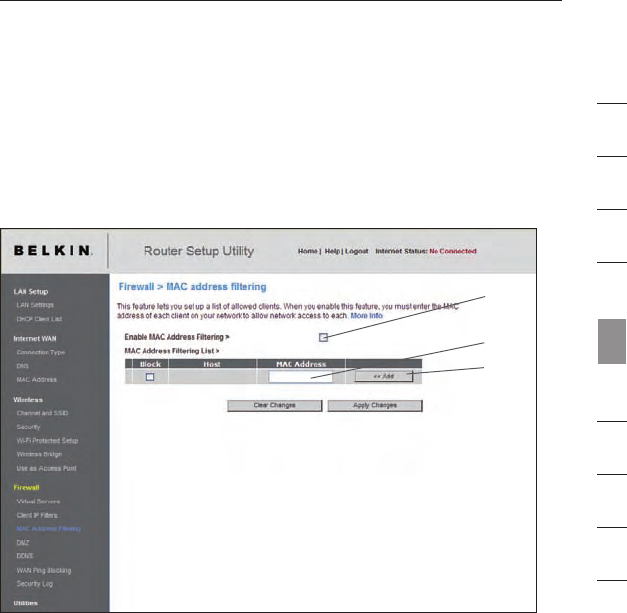
7372
7372
Using the Web-Based Advanced User Interface
section
1
9
2
3
4
5
6
7
8
10
Setting MAC Address Filtering
The MAC address filter is a powerful security feature that allows you
to specify which computers are allowed on the network. Any computer
attempting to access the network that is not specified in the filter list
will be denied access. When you enable this feature, you must enter
the MAC address of each client (computer) on your network to allow
network access to each.
(1)
(2)
(3)
To enable this feature, select “MAC Address Filtering” and click
“Enable MAC Address Filtering” (1). Next, enter the MAC address of
each computer on your network by clicking in the space provided (2)
and entering the MAC address of the computer you want to add to the
list. Click “Add” (3), then “Apply Changes” to save the settings. You
can have a MAC-address-filtering list of up to 32 computers.
Note: You will not be able to delete the MAC address of the computer
you are using to access the Router’s administrative functions (the
computer you are using now).
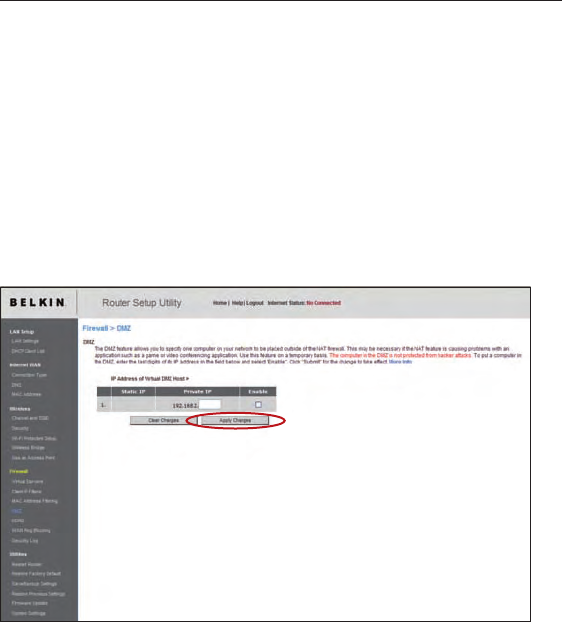
74
Using the Web-Based Advanced User Interface
74
Enabling the Demilitarized Zone (DMZ)
The DMZ feature allows you to specify one computer on your network to
be placed outside of the firewall. This may be necessary if the firewall
is causing problems with an application such as a game or video
conferencing application. Use this feature on a temporary basis. The
computer in the DMZ is NOT protected from hacker attacks.
Note: If your ISP subscription provides you with additional public (WAN)
IP addresses, additional computers can be placed outside the firewall
provided each computer uses a different public (WAN) IP.
To put a computer in the DMZ, enter the last digits of its IP address in
the IP field and select “Enable”. Click “Apply Changes” for the change to
take effect.

7574
7574
Using the Web-Based Advanced User Interface
section
1
9
2
3
4
5
6
7
8
10
Using Dynamic DNS
The Dynamic DNSSM service allows you to alias a dynamic IP address
to a static host name in any of the many domains DynDNS.org offers,
allowing your network computers to be more easily accessed from
various locations on the Internet. DynDNS.org provides this service,
for up to five host names, free to the Internet community.
The Dynamic DNS service is ideal for a home website, file server, or to
make it easy to access your home PC and stored files while you’re at
work. Using the service can ensure that your host name always points
to your IP address, no matter how often your ISP changes it. When
your IP address changes, your friends and associates can always
locate you by visiting yourname.dyndns.org instead!
To register free for your Dynamic DNS host name, please visit http://
www.dyndns.org.
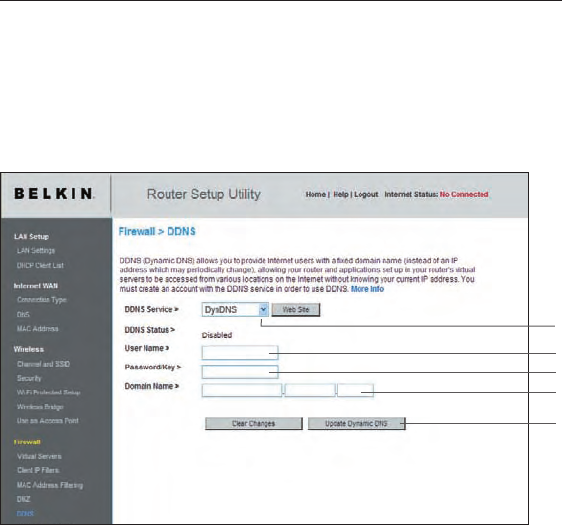
76
Using the Web-Based Advanced User Interface
76
Setting up the Router’s Dynamic DNS Update Client
You must register with DynDNS.org’s free update service before
using this feature. Once you have your registration, follow the
directions below.
1. Select DynDNS as the “DDNS Service” (1).
2. Enter your DynDNS.org user name in the “User Name” field (2).
3. Enter your DynDNS.org password in the “Password” field (3).
4. Enter the DynDNS.org domain name you set up with DynDNS.org in the
“Domain Name” field (4).
5. Click “Update Dynamic DNS” (5) to update your IP address.
Whenever your IP address assigned by your ISP changes, the Router will
automatically update DynDNS.org’s servers with your new IP address. You
can also do this manually by clicking the “Update Dynamic DNS” button (5).
(1)
(2)
(3)
(4)
(5)
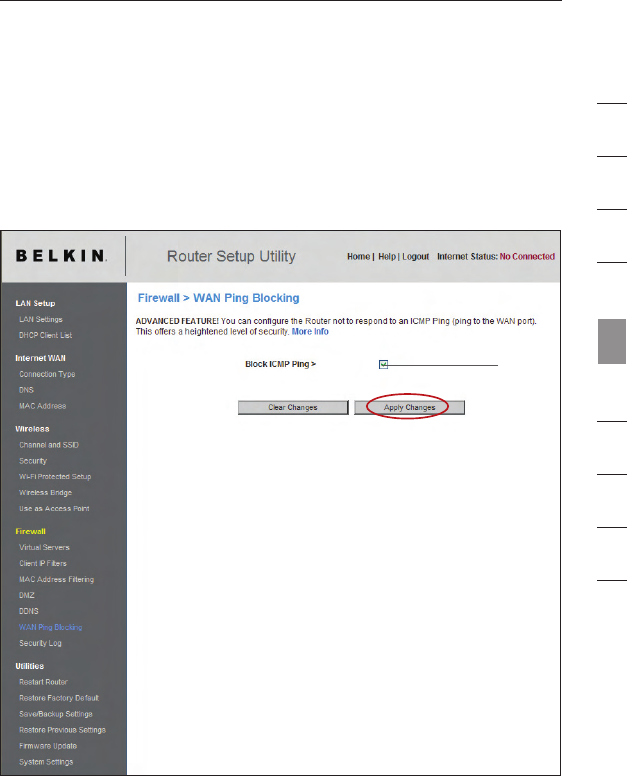
7776
7776
Using the Web-Based Advanced User Interface
section
1
9
2
3
4
5
6
7
8
10
WAN Ping Blocking
Computer hackers use what is known as “pinging” to find potential
victims on the Internet. By pinging a specific IP address and receiving
a response from the IP address, a hacker can determine that
something of interest might be there. The Router can be set up so it
will not respond to an ICMP ping from the outside. This heightens the
level of security of your Router.
To turn off the ping response, select “Block ICMP Ping” (1) and click
“Apply Changes”. The Router will not respond to an ICMP ping.
(1)
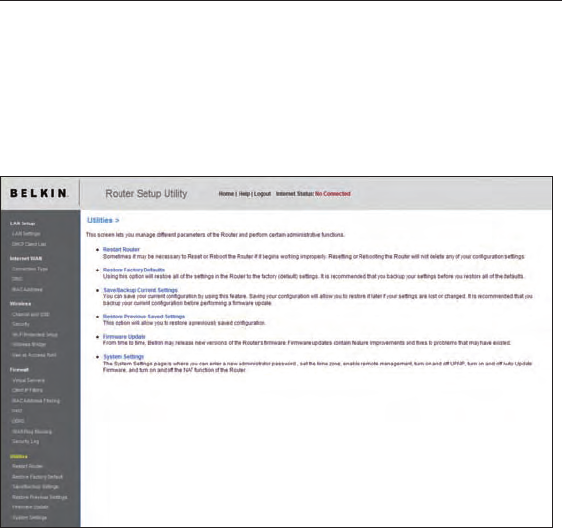
78
Using the Web-Based Advanced User Interface
78
Utilities Tab
This screen lets you manage different parameters of the Router and perform
certain administrative functions.
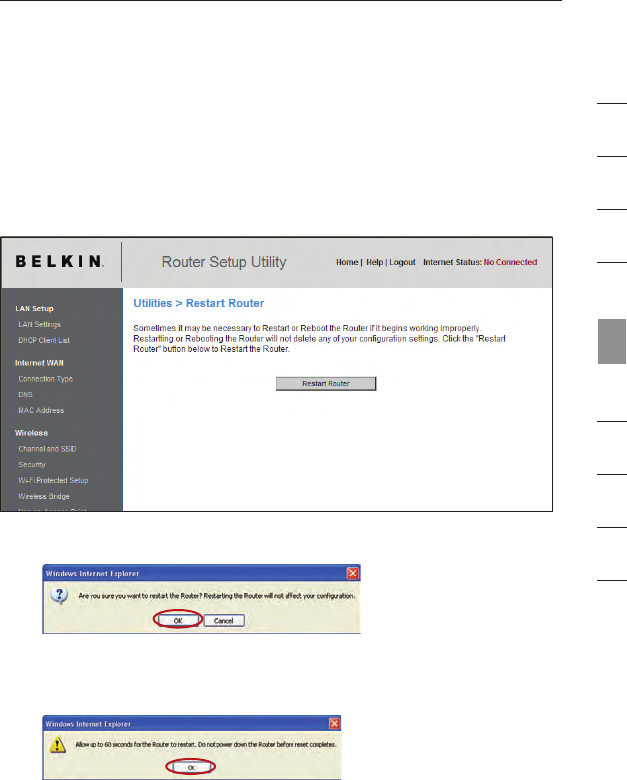
7978
7978
Using the Web-Based Advanced User Interface
section
1
9
2
3
4
5
6
7
8
10
3. The following message will appear. Restarting the Router can
take up to 60 seconds. It is important not to turn off the power
to the Router during the restart.
Restarting the Router
Sometimes it may be necessary to restart or reboot the Router if it begins
working improperly. Restarting or rebooting the Router will NOT delete any
of your configuration settings.
Restarting the Router to Restore Normal Operation
1. Click the “Restart Router” button.
2. The following message will appear. Click “OK”.
4. A 60-second countdown will appear on the screen. When the
countdown reaches zero, the Router will be restarted. The
Router’s home page should appear automatically. If not, type
the Router’s address (default = 192.168.2.1) into the navigation
bar of your browser.
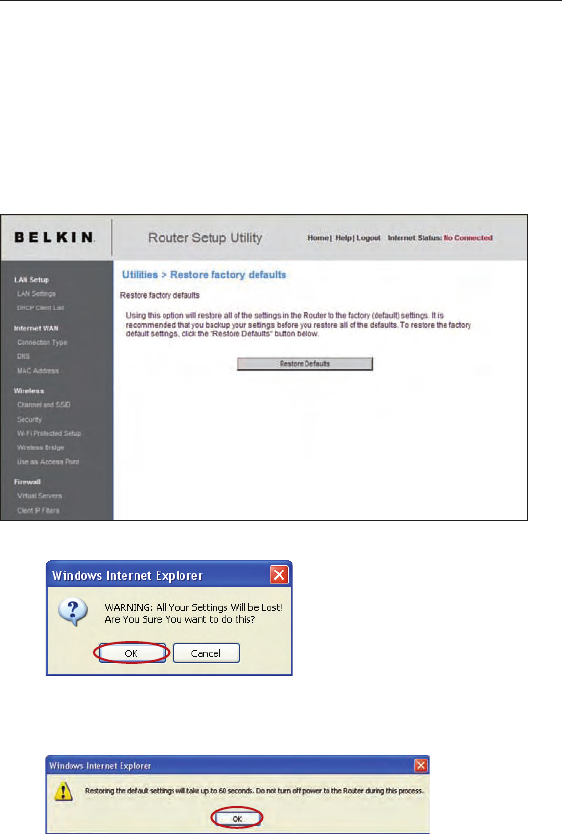
80
Using the Web-Based Advanced User Interface
80
3. The following message will appear. Restoring the defaults includes
restarting the Router. It can take up to 60 seconds. It is important not
to turn the power to the Router off during the restart.
4. A 60-second countdown will appear on the screen. When the
countdown reaches zero, the Router’s defaults will be restored. The
Router’s home page should appear automatically. If it does not, type
the Router’s address (default = 192.168.2.1) into the navigation bar of
your browser.
Restoring Factory Default Settings
Using this option will restore all of the settings in the Router to the factory
(default) settings. It is recommended that you back up your settings before
you restore all of the defaults.
1. Click the “Restore Defaults” button.
2. The following message will appear. Click “OK”.
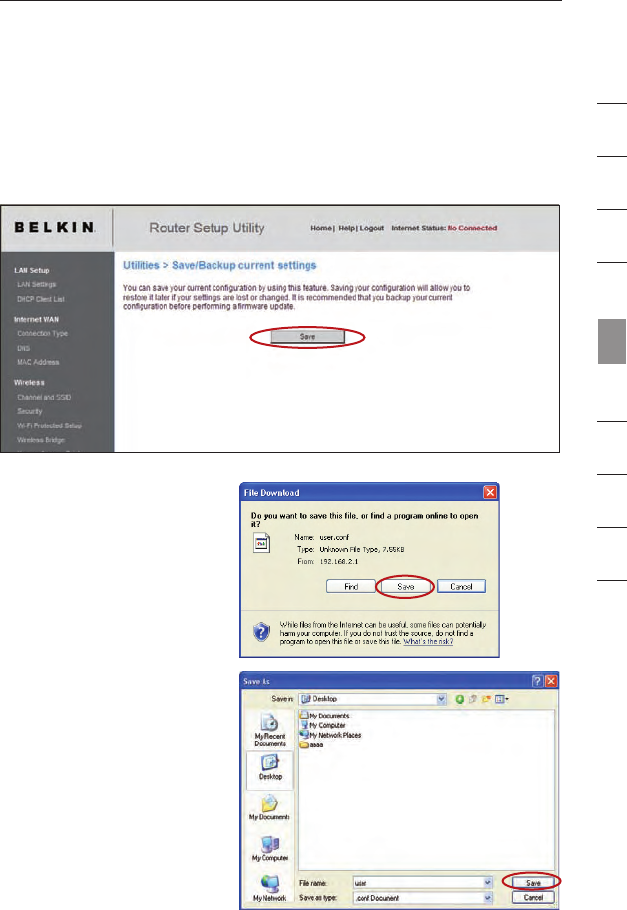
8180
8180
Using the Web-Based Advanced User Interface
section
1
9
2
3
4
5
6
7
8
10
Saving a Current Configuration
You can save your current configuration by using this feature. Saving
your configuration will allow you to restore it later if your settings are
lost or changed. It is recommended that you back up your current
configuration before performing a firmware update.
1. Click “Save”. A window
called “File Download”
will open. Click “Save”.
2. A window will open that
allows you to select the
location where you want
to save the configuration
file. Select a location.
You can name the file
anything you want, or
use the default name
“user”. Be sure to name
the file so you can locate
it yourself later. When
you have selected the
location and name of the
file, click “Save”.
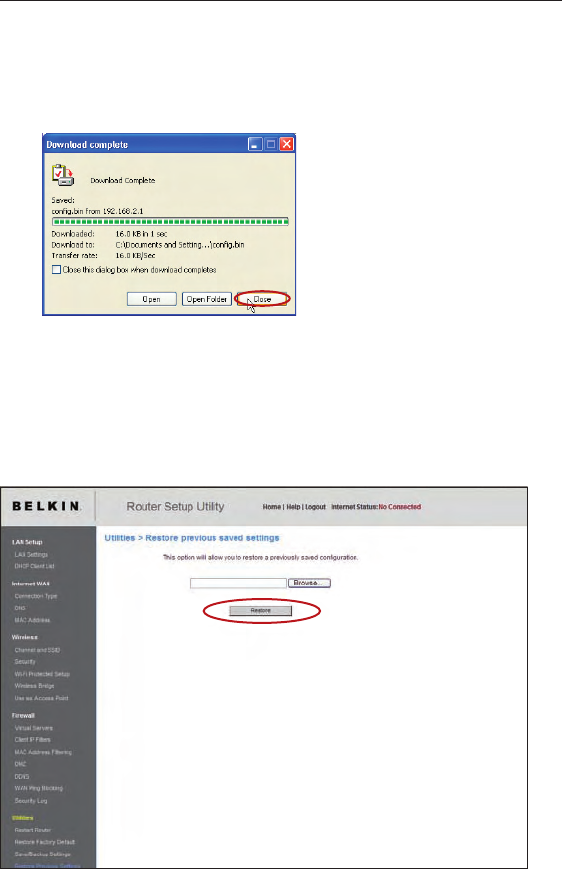
82
Using the Web-Based Advanced User Interface
82
3. When the save is complete, you will see the following window.
Click “Close”.
The configuration is now saved.
Restoring a Previous Configuration
This option will allow you to restore a previously saved configuration.
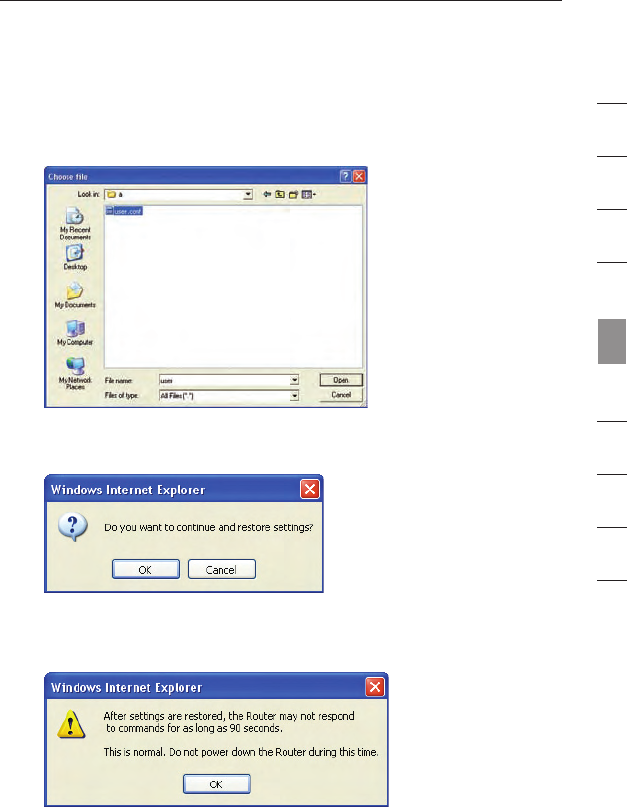
8382
8382
Using the Web-Based Advanced User Interface
section
1
9
2
3
4
5
6
7
8
10
1. Click “Browse”. A window will open that allows you to select the
location of the configuration file. All configuration files end with
a “.conf”. Locate the configuration file you want to restore and
double-click on it.
2. You will be asked if you want to continue. Click “OK”.
3. A reminder window will appear. It will take up to 90 seconds for
the configuration restoration to complete. Click “OK”.
4. A 90-second countdown will appear on the screen. When the
countdown reaches zero, the Router’s configuration will be
restored. The Router’s home page should appear automatically.
If not, type the Router’s address (default = 192.168.2.1) into the
navigation bar of your browser.
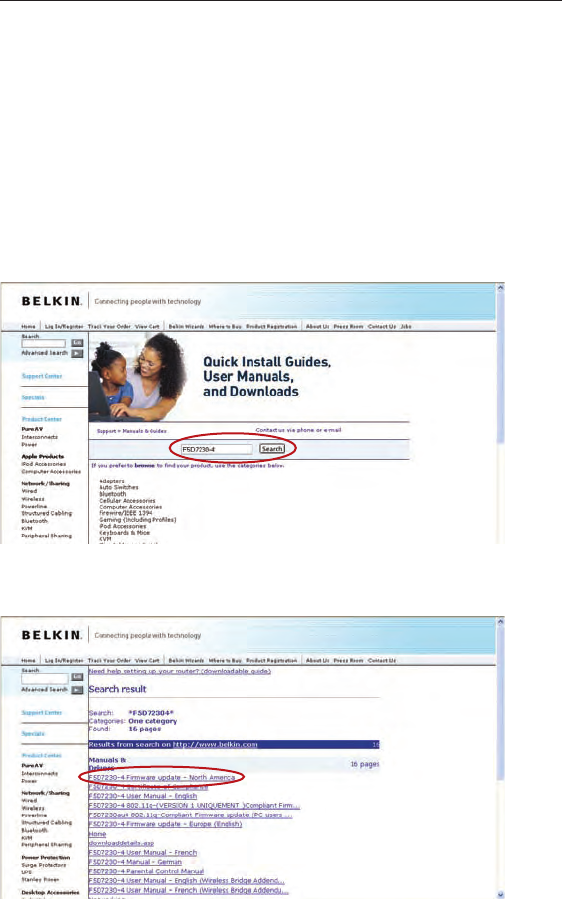
84
Using the Web-Based Advanced User Interface
84
Updating the Firmware
From time to time, Belkin may release new versions of the Router’s
firmware. Firmware updates contain feature improvements and fixes to
problems that may exist. When Belkin releases new firmware, you can
download the firmware from the Belkin update website and update your
Router’s firmware to the latest version.
Searching for a New Version of Firmware
From http://www.belkin.com/support/downloads.asp, type the Belkin
part number “F5D7230-4” in the “Search” field. Click “Search”.
From the results page, click “F5D7230-4 Firmware update -
North America”.
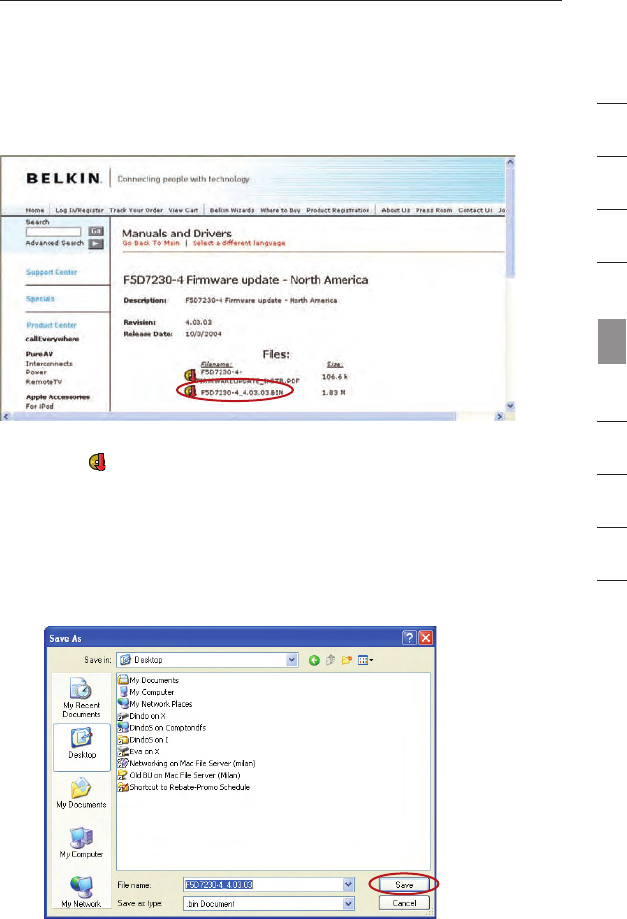
8584
8584
Using the Web-Based Advanced User Interface
section
1
9
2
3
4
5
6
7
8
10
Downloading a New Version of Firmware
You will now be taken to the download page of “F5D7230-4 Firmware
update - North America”.
1. To download the new version of firmware, click the download
logo ( ).
2. A window will open that allows you to select the location where
you want to save the firmware file. Select a location. You can
name the file anything you want, or use the default name. Be sure
to save the file in a place where you can locate it yourself later.
Note: We suggest saving this to your desktop to make it easy
to locate the file. When you have selected the location,
click “Save”.
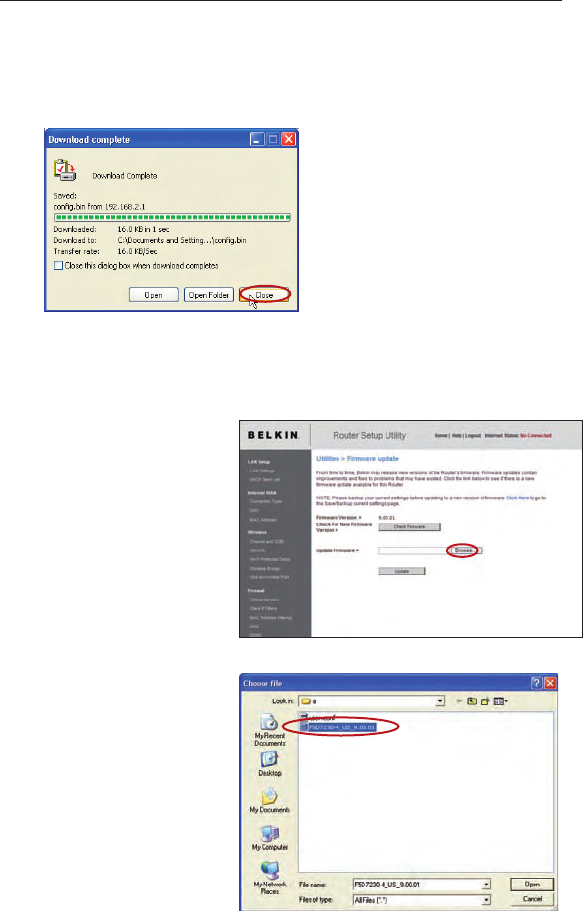
86
Using the Web-Based Advanced User Interface
86
3. When the save is complete, you will see the following window.
Click “Close”.
The download of the firmware is complete. To update the firmware, follow the
next steps in “Updating the Router’s Firmware”.
Updating the Router’s Firmware
1. In the “Firmware
update” page, click
“Browse”. A window
will open that allows
you to select the
location of the
firmware update file.
2. Browse to the firmware
file you downloaded.
Select the file by
double-clicking on the
file name.
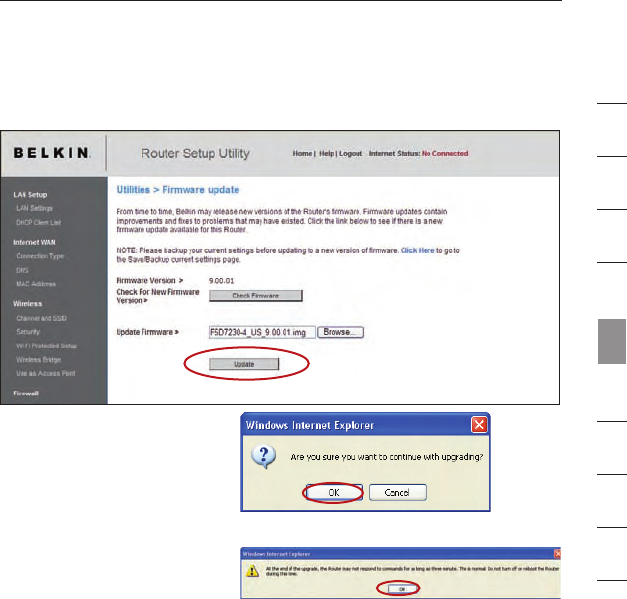
8786
8786
Using the Web-Based Advanced User Interface
section
1
9
2
3
4
5
6
7
8
10
3. The “Firmware update” box will now display the location and name
of the firmware file you just selected. Click “Update”.
4. You will be asked if
you are sure you
want to continue.
Click “OK”.
5. You will see one
more message. This
message tells you
that the Router may
not respond for as
long as three minutes
as the firmware is
loaded into the Router
and the Router is
rebooted. Click “OK”.
6. A second countdown will appear on the screen. When the
countdown reaches zero, the Router’s firmware update will be
complete. The Router’s home page should appear automatically.
If not, type the Router’s address (default = 192.168.2.1) into the
navigation bar of your browser.
The firmware update is complete.
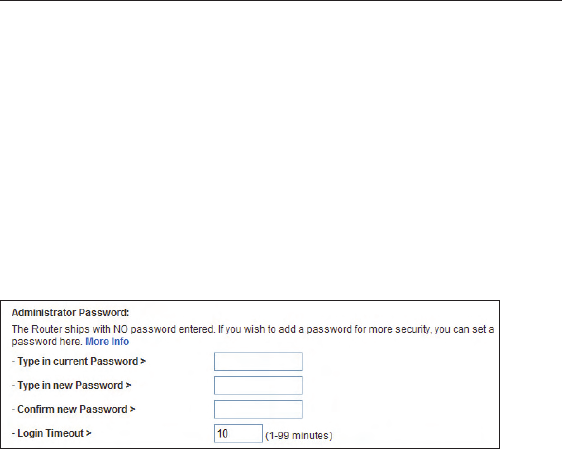
88
Using the Web-Based Advanced User Interface
88
Changing System Settings
The “System Settings” page is where you can enter a new administrator
password, set the time zone, enable remote management, and turn on and
off the UPnP function of the Router.
Setting or Changing the Administrator Password
The Router ships with NO password entered. If you wish to add a
password for greater security, you can set a password here. Write down
your password and keep it in a safe place, as you will need it if you need to log
into the Router in the future. It is also recommended that you set a password if
you plan to use the remote management feature of your Router.
Changing the Login Time-Out Setting
The login time-out option allows you to set the period of time that you can
be logged into the Router’s Web-Based Advanced User Interface. The timer
starts when there has been no activity. For example, you have made some
changes in the Web-Based Advanced User Interface, then left your computer
alone without clicking “Logout”. Assuming the time-out is set to 10 minutes,
then 10 minutes after you leave, the login session will expire. You will have
to log into the Router again to make any more changes. The login time-out
option is for security purposes and the default is set to 10 minutes.
Note: Only one computer can be logged into the Router’s Web-Based
Advanced User Interface at one time.
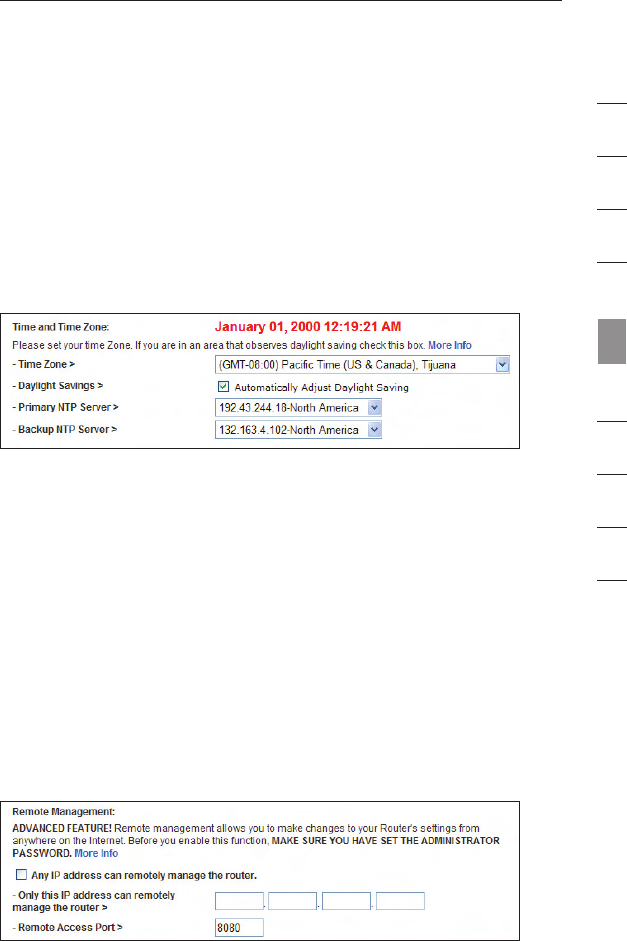
8988
8988
Using the Web-Based Advanced User Interface
section
1
9
2
3
4
5
6
7
8
10
Setting the Time and Time Zone
The Router keeps time by connecting to a Simple Network Time
Protocol (SNTP) server. This allows the Router to synchronize the
system clock to the global Internet. The synchronized clock in the
Router is used to record the security log and control client filtering.
Select the time zone that you reside in. If you reside in an area that
observes daylight saving, then place a check mark in the box next
to “Automatically Adjust Daylight Saving”. The system clock may not
update immediately. Allow at least 15 minutes for the Router to contact
the time servers on the Internet and get a response. You cannot set the
clock yourself.
Enabling Remote Management
Before you enable this advanced feature of your Belkin Router, MAKE
SURE YOU HAVE SET THE ADMINISTRATOR PASSWORD. Remote
management allows you to make changes to your Router’s settings
from anywhere on the Internet. There are two methods of remotely
managing the Router. The first is to allow access to the Router from
anywhere on the Internet by selecting “Any IP address can remotely
manage the Router”. By typing in your WAN IP address from any
computer on the Internet, you will be presented with a login screen
where you need to type in the password of your Router. The second
method is to allow a specific IP address only to remotely manage the
Router. This is more secure, but less convenient. To use this method,
enter the IP address you know you will be accessing the Router from
in the space provided and select “Only this IP address can remotely
manage the Router”. Before you enable this function, it is STRONGLY
RECOMMENDED that you set your administrator password. Leaving the
password empty will potentially open your Router to intrusion.
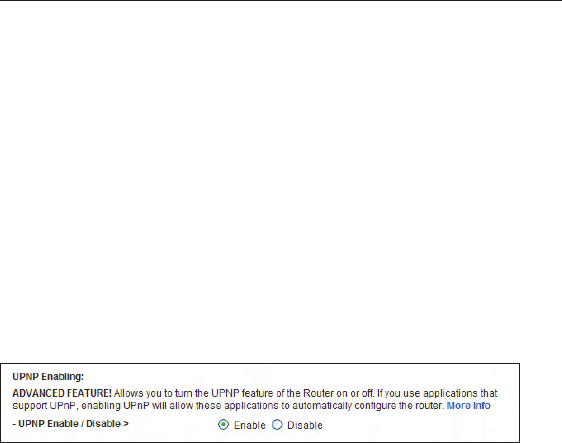
90
Using the Web-Based Advanced User Interface
90
Enabling/Disabling UPnP
UPnP (Universal Plug-and-Play) is yet another advanced feature offered
by your Belkin Router. It is a technology that offers seamless operation of
voice messaging, video messaging, games, and other applications that
are UPnP-compliant. Some applications require the Router’s firewall to
be configured in a specific way to operate properly. This usually requires
opening TCP and UDP ports. An application that is UPnP-compliant has
the ability to communicate with the Router, basically “telling” the Router
which way it needs the firewall configured. The Router ships with the
UPnP feature enabled. If you If you want to disable the UPnP feature,
simply select “Disable” in the “UPnP Enabling” section of the “Utilities”
page. Click “Apply Changes” to save the change.